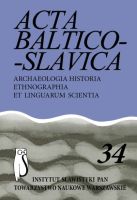Rosyjskie skrótowce porewolucyjne w pierwszych radzieckich słownikach dwujęzycznych
Russian post‑revolutionary abbreviations in the first bilingual russian dictionaries
Author(s): Jolanta MędelskaSubject(s): Language and Literature Studies
Published by: Instytut Slawistyki Polskiej Akademii Nauk
Keywords: the Polish Russian language; bilingual lexicography; abbreviations
Summary/Abstract: The process of real expansion of abbreviations started at the end of 19th century and it developed tremendously in 20th century. The process of creating abbreviations in Russian became active after World War I and suddenly became widespread particularly in the post-revolutionary period. At that time abbreviations were created spontaneously and in a disorganized way, yet numerous creations were commonly used. The period of time during which they were used was usually short, compare: ОСОАВИАХИМ (= Общество содействия обороне, авиации и химическому строительству). In most cases they were names of political parties, combat, revolutionary, social and other organizations, for instance: волисполком, военкомат, ревком. This characteristic type of Russian lexis was very troublesome for Polish intellectuals who were trying to code the Polish Russian language, i.e. specific, language code with many Russian and Soviet idioms that was used by the Polish living in the Soviet Union during the post-revolutionary period. Attempts to standardize abbreviations were reflected in translation dictionaries (Polish-Russian and Russian-Polish) published in Moscow in the 30s of 20th century.
Journal: Acta Baltico Slavica
- Issue Year: 2010
- Issue No: 34
- Page Range: 73-87
- Page Count: 15
- Language: Polish

